Menus
- Easy girl
- The SP version of the Fireblade pushes the concept of Total Control dear to Honda to its climax, namely offering an ultra efficient machine and disarming ease. Mission successful but it will be necessary to pay the price !
- Presentation
- In the saddle
- On track
- Accessories
- Conclusion
Easy girl
The SP version of the Fireblade pushes the concept of Total Control dear to Honda to its climax, namely offering an ultra efficient machine and disarming ease. Mission successful but it will be necessary to pay the price !
The Honda Fireblade is a machine apart from the Honda lineup. Since the appearance of the first model in 1992, the Japanese manufacturer has always been committed to delivering machines sticking to the concept of Total Control. Understand by this motorcycles that are both efficient AND easy, able to get the best out of the pilot who is hidden (or not) in us. A relevant concept since Honda has sold more than 200,000 in the space of two decades. Certainly, sports cars are no longer on the rise in the charts and the golden age when manufacturers thoroughly overhauled their machines every two years and over. However, the world’s leading manufacturer is not standing still and is delivering an SP version for 2014 for the track, refined in detail and incorporating Ohlins suspensions, a guarantee of quality and thoroughness. Considering the winter period, Honda sent us to Qatar on the Doha track to test its novelty.
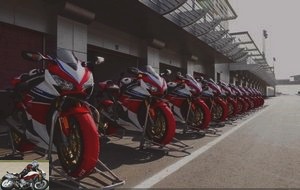
A good idea, given that even in the south of Spain, the thermometer struggles to pass the 10 degree mark…
Presentation
Before talking about the SP version of the CBR 1000 RR, we must address the case of the standard 2014 version. On the basis of the 2013 vintage, Honda carried out a regular refresh of its hypersport..
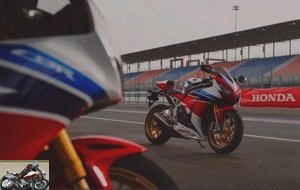
On the engine side, the four-cylinder in-line saw its power go from 176 (12,000 rpm) to 178 horsepower (12,250 rpm) while the torque climbed from 112 Nm (8,500 rpm) to 114 Nm ( 10,500 rpm). Do not be fooled by this higher perched value, the torque curve being much more filled between 4 and 6000 rpm. This increase in performance is primarily achieved through improved flow flow at high speeds in the intake and exhaust. The intake pipes are now bevelled, the ducts are entitled to smooth curvatures and polish, and the valve seats have been redesigned. The exhaust has also been completely revised: diameter reduced from 38 to 35 mm, addition of an interconnection tube between cylinders 2 and 3, catalyst with a larger section transferred upstream of the silencer, new plenum chamber … everything is obviously associated with a complete reconfiguration of the control unit managing the double sequential injection PGM DFSI.
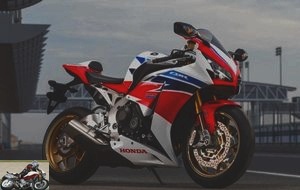
Regarding the chassis, Japanese engineers have focused on improving feedback by improving flexibility at the junction between the frame and the swingarm. According to Honda, this modification initially developed for the SP version with Ohlins suspensions was also carried over to the standard version as it proved to be beneficial to road holding and traction. Finally, the driving position has slightly gained in aggressiveness. The bracelets are more apart (+ 34 mm) to improve the lever arm and their angle has been opened (+ 5 °) and lowered (- 5 °). the footrests are set back a centimeter. Finally, the 2014 vintage is entitled to the tweaking of a few odds and ends as practical on a daily basis as useless for the lambda biker to be lathered at the corner troquet: new double curvature bubble improving the protection of the pilot (at least when he is pressed against the tank), redesigned tank cover to improve ventilation and even a new “wave” type ignition key which is safer and shorter to limit unwanted twists and holes in the pockets.
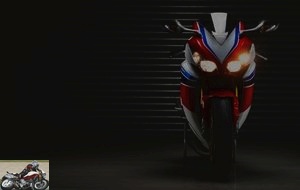
To this set of modifications, Honda has added for its SP version everything it takes to make it a queen of the chrono lap. The engine benefits from original metrology through a more drastic selection of its moving parts. Where Honda usually allows itself a variation of 3 grams on the selection of its connecting rods and pistons, the tolerance on the SP has been reduced to only 1 gram! And then of course there are the Ohlins suspensions. Up front, there is a 55m diameter NIX30 (54 for the original Showa) designed specifically for Miss SP, both in terms of the tubes and the fork legs. The junction with the frame is also entitled to its share of improvements. The tees as well as the column axis pass from aluminum to steel to improve rigidity and the upper tee, with the increased contact surface, is no longer cast but forged (always for the same reasons for those who know nothing about metallurgy). Without transition, let’s go to the rear with a magnificent model TTX 36. The press kit is not very talkative about the amplitude of the settings but we know that the “track” type hydraulics will be less comfortable on asphalt. degraded. Let’s move on to the brakes with Brembo monobloc with asymmetric pistons (30 and 32 mm) and special pads intended to optimize the feeling during braking at high speed. Quite a program … The track version requires, the SP is a strict single-seater which allows it to adopt a lighter rear loop. On the scale, this translates to a weight of only 199 kg for the version without C-ABS (+11 kg). I would tell you in detail about this famous system, also equipped with optimized settings on the SP, but this option will unfortunately not be available in France. And then there are the socks, Pirelli Diablo Supercorsa “SP”, suitable for mixed road-track use..
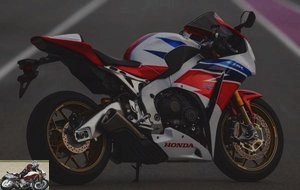
In the saddle
Before taking the runway, we are introduced to the luxury babysitters who will supervise us. There, Honda drew heavy, even very heavy, with the Haslam family (old Ron and young Leon), Sebastien Gimbert (Editor’s note: top with his integration into the Honda endurance and FSBK team for 2014 !!! ) who has as many Bol d’Or and 24 H du Mans victories as I have T-shirts in my closet (I have plenty!), as well as the immense John McGuinness, 20 times winner of the Tourist Trophy.
But let’s go back for a few moments to our mount of the day. In terms of finish, it’s Honda "made in Japan" all spitting. Everything is beautiful, perfectly adjusted, with no protruding wires or tear-off deburring. In short, a quality thing made to last.
The instrument cluster is taken from the previous vintage. Overlooking a bar incorporating the usual indicator lights (flashing, reserve, neutral, etc.) the multifunction LCD screen is equipped with a bar graph tachometer, an odometer and permanently displays the gear engaged, the temperature of water, time, total and partial mileage. Note that the display of the engine speed can be set according to four different modes: Conventional, Inverted (Reverse) where the bars go out instead of lighting up, Peak Hold which in addition to the conventional mode displays the maximum speed reached and finally Single Segment to be compared to a traditional tachometer since it only displays one bar at a time. Additionally, the odometer can be changed to display engine speed. The LCD screen can also switch to track mode to display and store timed laps and display average or instantaneous fuel consumption, distance traveled and a timer. Above the LCD screen is a bar incorporating 5 shift light LEDs that gradually light up as they approach the red zone before flashing at a preset speed (default at 13,000 rpm). Their intensity is adjustable, as are the ignition intervals (0, 200 or 400 rpm) and the intervention speed (between 4,000 and 13,000 rpm).

Once in the saddle, we have all the phalanges of the feet on the ground from 1.70 m but little more.
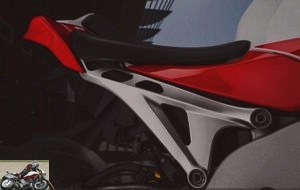
And once in motion, the position is certainly sportier than in the past, but we are still far from the radicalism of a Triumph Daytona 675 or a Yamaha R6. Nothing to report on the ergonomics of the various controls either, everything is well placed and firm as it should be. History of quibbling, we would have liked a micrometric screw to adjust the brake lever clearance rather than the traditional 6-position eccentric. As for the level of the 4 cylinders at start-up, the SP is discreet (higher in the towers also for that matter …) but Honda France will deliver its SP with an Akrapovic silencer, most likely more sound -and lighter- than the origin.
On track
The first handling sessions are carried out with the original fitment, Pirelli Diablo Supercorsa “SP”, designed for mixed road-track use. Despite tire pressures that are too high (we won’t find out until later), the SP can be tamed without any specific instructions..
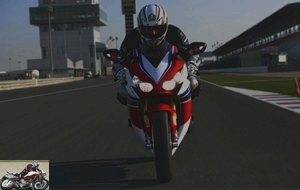
So much the better because the Losail circuit is relatively difficult to master with very few landmarks and a few “false brothers” bends which look alike on entry but not at all on exit … The first laps then take more than improvisation than piloting and in these very special conditions, the CBR 1000 RR SP is your ally. Agile, it requires little effort when setting the angle and never locks in its path, even in the event of catastrophic braking. In tight corners, the front end of the SP sits down to the millimeter, and the overall low inertia feels like a smaller machine. Admittedly, a Kawasaki ZX-10 R is probably even more agile, but the driving sensations are different. On most hypersport cars, the feeling comes mainly from the front axle with more diffuse feedback at the rear.
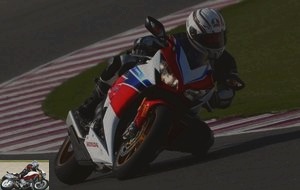
On the SP, you can feel everything that is happening on the machine, whether it is at the level of mass transfers or the work of the suspensions. This in itself does not guarantee greater efficiency, but it is subjectively very reassuring. Especially when your knee is on the ground at over 150 km / h … But it’s on the long presses that the SP is most impressive. Very reassuring, it always seems firmly fixed on its trajectory but it is enough to play the supports on the footrests to tighten smoothly an approximate trajectory. The change in the afternoon to more efficient pneumatic equipment (Supercorsa SC) will only highlight these qualities even more despite a much higher pace..
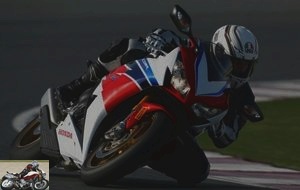
Approaching the braking from the end of the straight at 290 km / h (over 300 for some colleagues) before tackling a corner in seconds, the SP is imperative for stability despite the incredible stopping power of the Brembo radial calipers. Same remark during strong acceleration or the chassis never seems overwhelmed by the almost 180 horsepower. This ability to digest large mass transfers without flinching while offering a fine “reading” of the work of the tires is to the credit of the Ohlins suspensions and the work of stiffening and the gain is noticeable in all phases of driving. Suddenly, even when the pilot is driving at his maximum speed, even sometimes beyond, the MS remains easy and considerate..
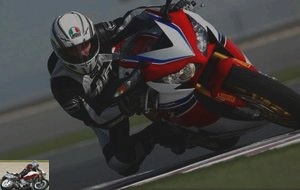
The engine also contributes to this general ease with a controlled arrival of power. Docile under the bar of 4000 rev / min, it really wakes up at 6000 revs by offering muscular revivals. But to take advantage of its full potential on the track, it will have to be kept above the 8,000 rpm mark, which leaves around 5,000 laps of headroom before hitting the switch. The dosage of the arrival of power – the famous accelerator / rear wheel connection – is excellent most of the time but the SP gave us a few jerks on the restart in a random way. This detail aside, the 4-cylinder of the SP is typical of the brand’s productions: docile, efficient but lacking a little character in the face of the competition..
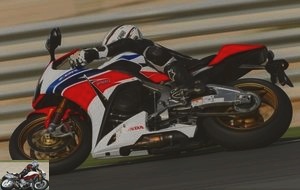
Let’s come back to braking. If the power is at the top, the brutal lever attack will take some getting used to. Another annoying detail on a machine of this standing, a spongy touch, typical of machines without “aviation” hoses. According to Sebastien Gimbert, the feeling of the French versions without ABS should be much better. To be checked during a next test, on the road, longer.
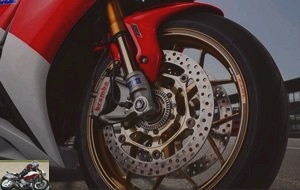
Accessories
The CBR 1000 RR SP can be personalized with a whole series of in-house accessories also benefiting from a two-year warranty: protective flap for the shock absorber, carbon elements (mudguards, crankcases), brake pads. protection, workshop stand … Outside of the track world, you can also fall back on an alarm, a high screen, a comfort saddle, protective covers, a charge controller for the battery and even a tank.
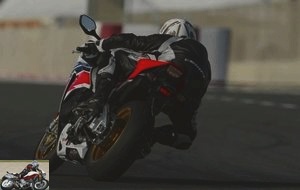
Conclusion
Judging the efficiency of a hyper sports car is always a difficult exercise because unless you have solid track experience, you reach the end of your own skills well before those of the machine. Once this observation has been made, the SP is a bluffing machine of efficiency for an “average” driver, perfectly adhering to the concept of Total Control so dear to the brand. Against the avalanche of electronic crutches offered by the competition (moreover as effective as they are practical), it opposes a disarming ease of driving coupled with a formidable efficiency and only the consistency of the brakes tarnishes an almost perfect picture. There remains the thorny issue of the tariff. To afford this “full Ohlins” CBR 1000 RR, you will have to pay an invoice of almost € 18,000 for a machine clearly intended for track use and delivered in France without C-ABS but with an Akrapovic silencer. The standard version, less efficient but more versatile in the context of mixed road-track use, should be negotiated around € 14,000 and may have the option of C-ABS.
Strong points
- Impeccable road holding
- Bluffing ease of driving
- Performances
- Build quality
Weak points
- Spongy front brake
- Rate
Datasheet
Related articles
-
Honda CBR 1000 RR Fireblade test
The era of e-Total Control A quarter of a century has seen the evolution of one of the most efficient and unique sports cars in the segment: the CBR…
-
Honda Integra 750 maxi-scooter test
The biker scooter Apply to the motorcycle what the manufacturer was already doing for the car…. that is to say use a common base to decline several…
-
Waiting for the new Hornet… No, the CB 650 F is not the replacement for the Hornet. Healthy, easy and fast enough, it is intended primarily for…
-
Four cylinders in line, 1140 cm3, 90 hp at 7,500 rpm, 91 Nm at 5,500 rpm, 252 kilos, € 12,999 A more sporty version of the neo-retro roadster 2013: in…
-
The small large gas turbine The brand’s historic sports car, the CBR 600 RR is a sure bet for efficiency and performance. Rather than the ultimate quest…
-
The fully equipped Dolce Vita Big wheels, lines and Italian style, the SH has been one of Honda’s flagship scooter lines since 2001, with over a million…
-
Honda NC 700 S motorcycle test
Crisis solution Honda revives the basic motorcycle with its NC 700 S: a floor price, practical aspects borrowed from the scooter and consumption at the…
-
Honda CB1100R T-Rex motorcycle test
The best Post-Classic sports car ever built 4 cylinders in line, 1,156 cm3, 145 hp, 160 kg, Harris frame, 273 km / h A T-Rex is big, strong, powerful ……
-
Honda Africa Twin CRF1100L Adventure Sports motorcycle test
100 hp, 105 Nm at 6,250 rpm, 238 kg all full (250 kg in DCT / EERA), 16,899 euros (19,399 euros in DCT and EERA suspensions). The spirit is there It…
-
Tame shrew Introduced year after the Yamaha 500 RDLC and at the same time as the RG 500 Suzuki, Honda unveiled its 2-stroke replica in 1985: the NS 400…